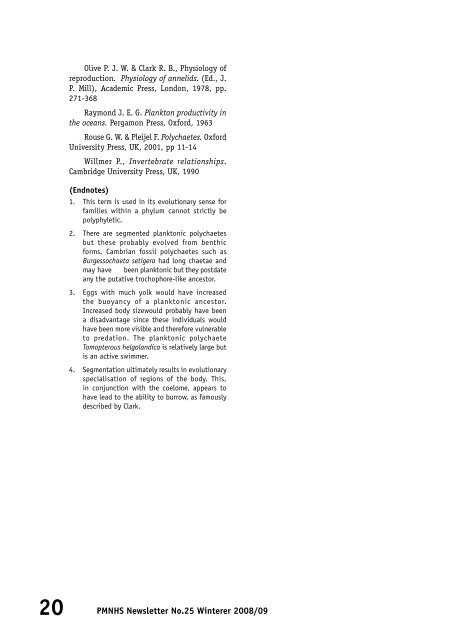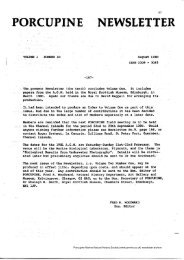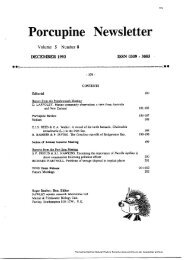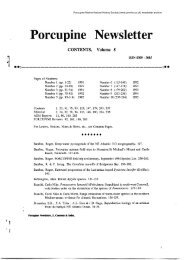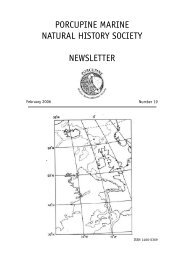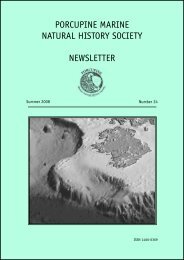Olive P. J. W. & Clark R. B., Physiology ofreproduction. Physiology of annelids. (Ed., J.P. Mill), Academic Press, London, 1978, pp.271-368Raymond J. E. G. Plankton productivity inthe oceans. Pergamon Press, Oxford, 1963Rouse G. W. & Pleijel F. Polychaetes. OxfordUniversity Press, UK, 2001, pp 11-14Willmer P., Invertebrate relationships.Cambridge University Press, UK, 1990(Endnotes)1. This term is used in its evolutionary sense forfamilies within a phylum cannot strictly bepolyphyletic.2. There are segmented planktonic polychaetesbut these probably evolved from benthicforms. Cambrian fossil polychaetes such asBurgessochaeta setigera had long chaetae andmay have been planktonic but they postdateany the putative trochophore-like ancestor.3. Eggs with much yolk would have increasedthe buoyancy of a planktonic ancestor.Increased body sizewould probably have beena disadvantage since these individuals wouldhave been more visible and therefore vulnerableto predation. The planktonic polychaeteTomopterous helgolandica is relatively large butis an active swimmer.4. Segmentation ultimately results in evolutionaryspecialisation of regions of the body. This,in conjunction with the coelome, appears tohave lead to the ability to burrow, as famouslydescribed by Clark.20PMNHS <strong>Newsletter</strong> No.<strong>25</strong> <strong>Winter</strong>er <strong>2008</strong>/09
Information Requests and ObservationsEndangered swordfish found onSouth Wales beachPress release from National Marine AquariumContact: Douglas Herdson, InformationOfficer, National Marine Aquarium, Rope Walk,Coxside, Plymouth PL4 0LF, UK Douglas.Herdson@national-aquarium.co.ukOr – Nadine Simpson, Marketing, Nadine.Simpson@national-aquarium.co.ukOn Thursday morning 3 rd July <strong>2008</strong>, thebody of a large fish was found washed up onBarry Island beach, Vale of Glamorgan, SouthWales. It was a torpedo-shaped fish over sixfeet long, with a long snout, a crescent tail andcurved back fin. It was obviously a “billfish”one of the group containing swordfish andmarlins. Colin Smith of the Vale of GlamorganCouncil was soon on to it and contacted theMarine Conservation Society. They in turn puthim on to Doug Herdson at the National MarineAquarium in Plymouth, who manages the UKMarine Fish Recording Scheme. The recordsshow that while swordfish are rare, they doturn up from time to time in the waters aroundthe British Isles; but there have only ever beenthree marlins found in the UK.Photo - National Museum of WalesPhotographs of the fish were sent toPlymouth and from these it was possible toidentify it as a Swordfish Xiphias gladius(“Pysgodyn cleddyf” in Welsh) as expected.The fish has since been taken to the NationalMuseum Wales (Amgueddfa Cymru) whereit will enter the national collection. Onarrival, it was carefully examined by Dr PeterHowlett, the Curator of Lower Vertebrates,who confirmed the identification and foundit to be a young specimen 2.24 metres longand between 60 and 80 kg in weight. It hadbeen dead only a few days, but it had beenscavenged by other creatures and it was notpossible to determine the cause of death.Swordfish can grow to 4.6 metres (16 ft)and weigh over 600 kg, so this one was a tiddlerin global terms. They are often called a BroadbilledSwordfish, but there is only one speciesin the world. They are found throughout thetropical and temperate waters of the world butappear to prefer sea temperatures of 18°C to22°C, migrating to cooler waters to feed inthe summer. These oceanic fish chase herringand mackerel and are among the fastest fishreaching 90 km.h -1 (56 m.p.h.). This is in partdue to their being warm-blooded, which allowsnot only their muscles but also their brain andeyes to work more efficiently.By 1998 the swordfish population of theNorth Atlantic was thought to have declined,due to overfishing, to only 35% of its originalsize. Once mature a female can produce 30million eggs each year, giving the stock thecapability of rapid recovery. However thefemales do not mature until they reach 70kg, and the average size now landed is amere 40 kg. When the population was firstcommercially targeted in the early nineteenthcentury the average fish landed weighed over200 kg. Such a decline is a classic feature ofoverfishing. Drastic fisheries control measuresare now in force for swordfish in the NorthWest Atlantic, but it is disputed as to howeffective these have been and it is claimedthat the stock is still at only half the level ofa sustainable population.Unfortunately, with stocks at these levelsswordfish steak must now be on the “fish toavoid” list. It is to be hoped that effectivefisheries management can be enforced in boththe West and the East North Atlantic so thatwe can once again enjoy this delightful fish,both in the wild and on the plate.PORCUPINE PROBLEMSPMNHS <strong>Newsletter</strong> No.24 Summer <strong>2008</strong> 21


